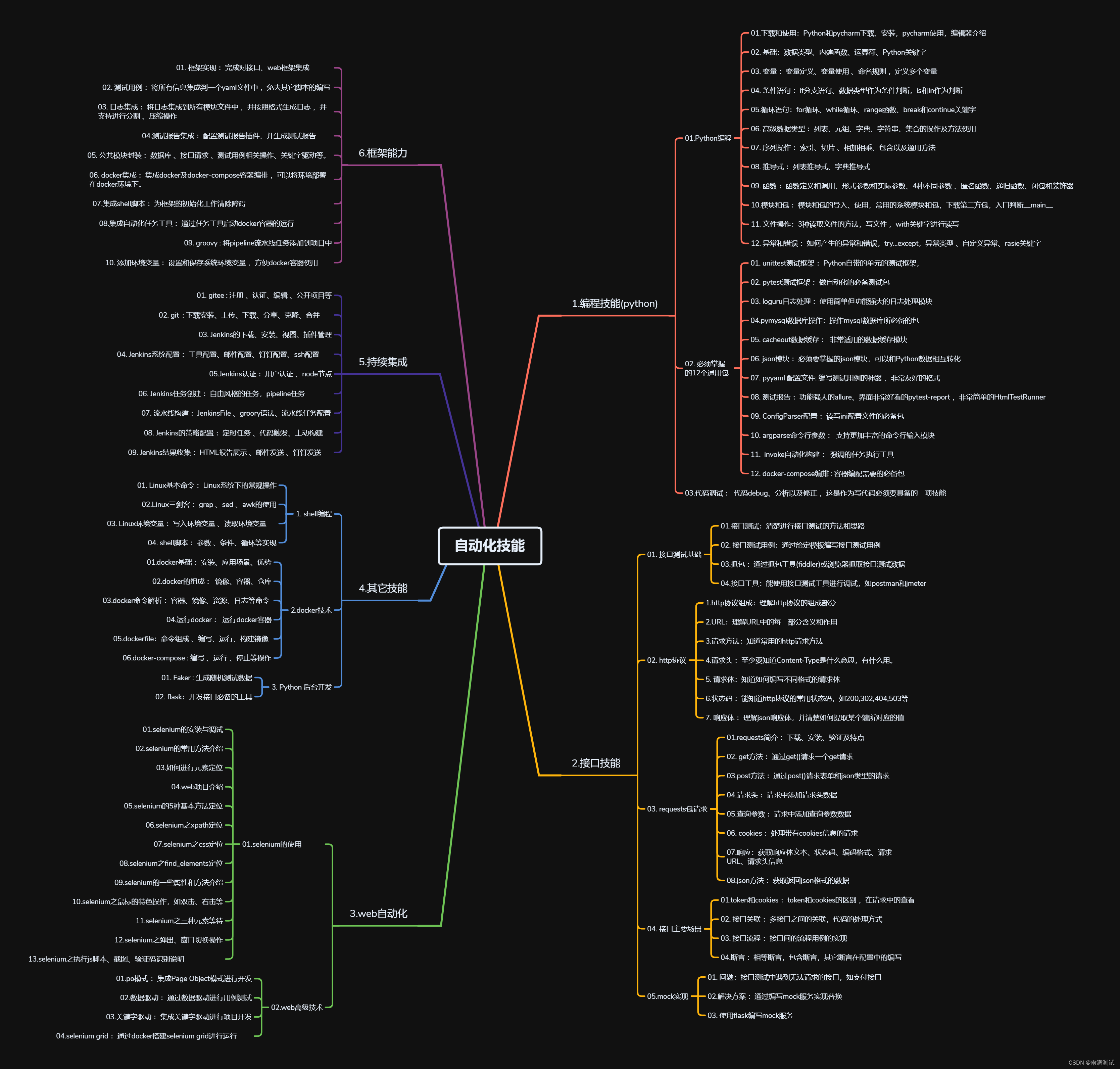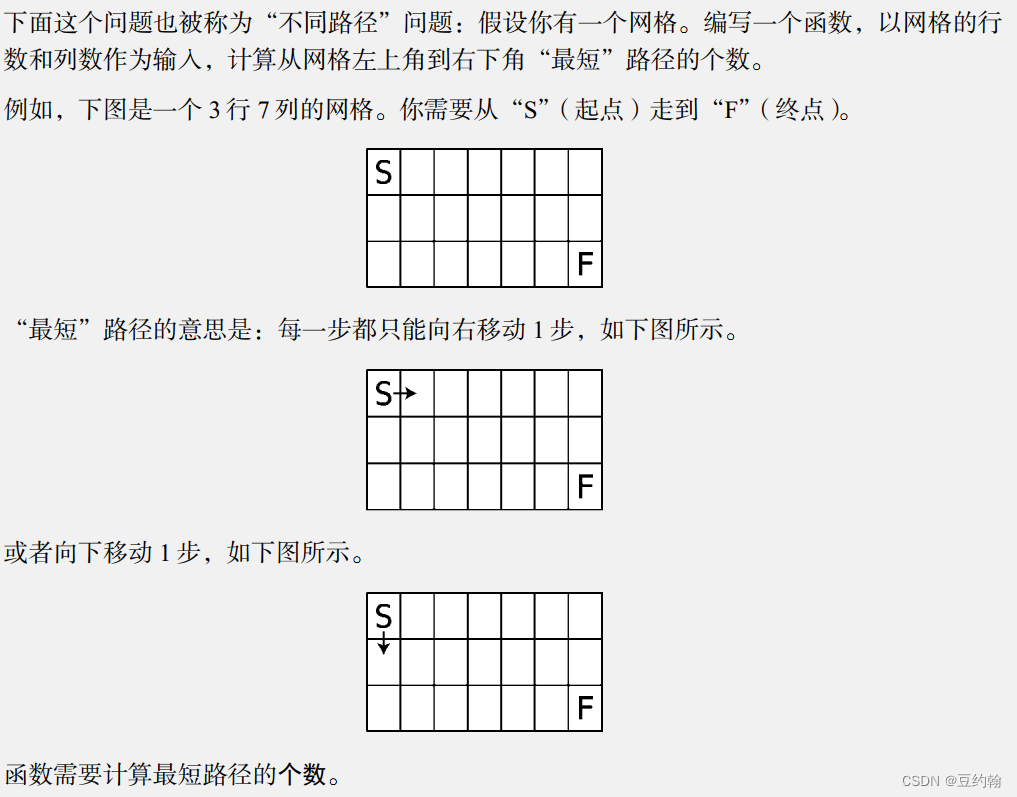硬件准备
ADSP-21479EVB开发板:
产品链接:https://item.taobao.com/item.htm?id=555500952801&spm=a1z10.5-c.w4002-5192690539.11.151441a3Z16RLU

AD-HP530ICE仿真器:
产品链接:https://item.taobao.com/item.htm?id=38007242820&spm=a1z10.5-c.w4002-5192690539.11.59ae4901jeWaOn
软件准备
Visual DSP++5.1.2
CCES2.11.1
音频开发: 21479 AD1939 C Block-Based Talkthru 48 or 96 kHz(4 进 8 出)
这个程序,我们将会在开发板上实现 48Khz 或 96Khz 采样率的音频直通程序。原理上来 讲,手机或者 PC 的音源通过 1 分 2 音频线接入 21479 开发板的模拟输入接插件,将模拟音 频导入,通过 AD1938 进行模拟转数字,数字音频信号进入 21479 数字音频 DSP 中,不做任何处理,交给 AD1938 再进行数字转模拟,将模拟的音频信号送到对应的通道,实现多 通道输出。
硬件连接如下图:
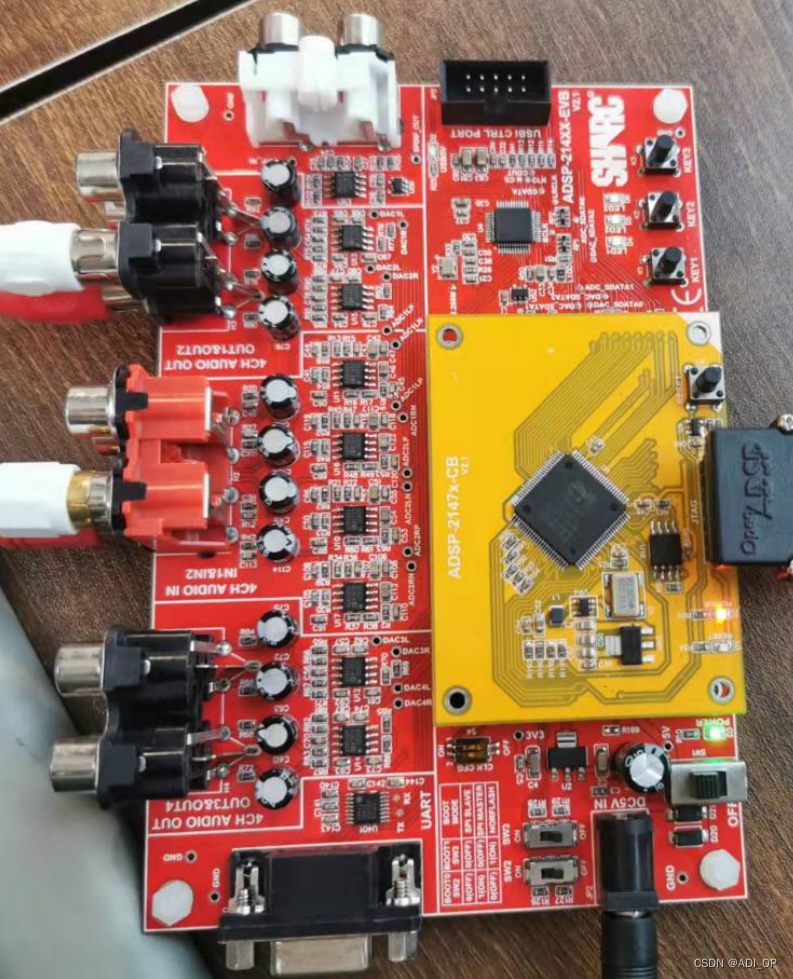
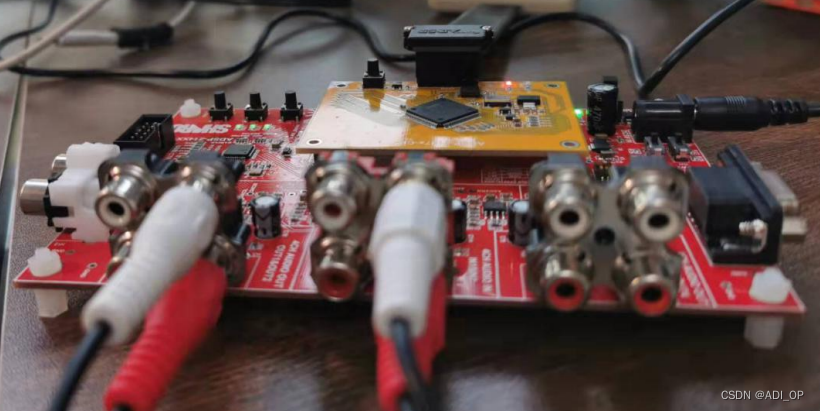
为什么输入接 2/3 通道,输出接 2/3 通道(通道号在板子的背面的丝印),这是因为 程序就是这么写的的,我们来看看程序是怎么写的: 把工程拖入 VDSP 中,编译,运行,手机播放音源,输出到音响听到音乐,完成这个例程。

看看这个程序的 Readme,代码实现了 ADC 从 2/3 进,DAC 从 0/1 和 2/3 出。ADC 从 0/1 进,DAC 从 4/5 和 6/7 出。用户可以换一下输入输出接口,听一下效果。至于板子上哪个接 口是 0/1,哪个是 2/3?请看下图,红色的接插件是输入,2 个黑色的接插件是输出:
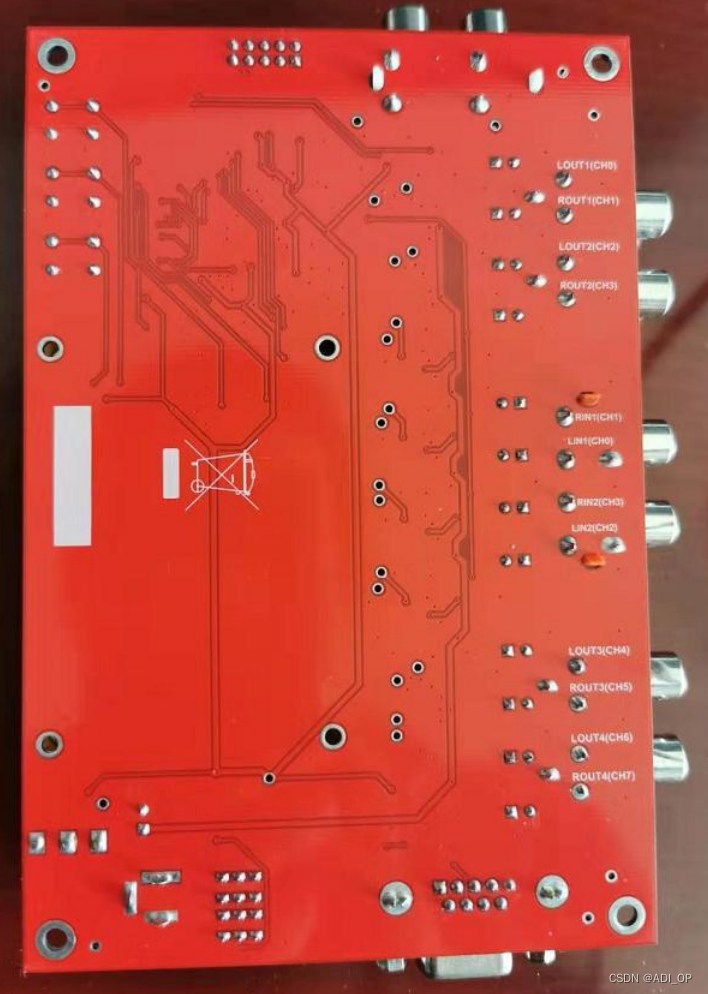
这个工程里,音频处理都在 DSP Audio Processing Routines 里,想要了解如何实现这种 直通,可以看里面的程序去理解。 程序里都有备注,比较容易看得懂,这里说的就是 4 进 8 出,1 左右声道进对应 12 左 右声道出,2 左右声道进对应 34 左右声道出。而 1 左右声道 IN 就是板子上的 0/1 IN,2 左右声道 IN 就是板子上的 2/3 IN。
核心代码分析
DSP
///
// //
// NAME: blockProcess_audio.c (Block-based Talkthrough) //
// DATE: 02/06/10 //
// PURPOSE: Process incoming AD1939 ADC data and prepare outgoing blocks for DAC. //
// //
// USAGE: This file contains the subroutines that float and fix the serial data, //
// and copy from the inputs to the outputs. //
// //
///
#include “ADDS_21479_EzKit.h”
// Define a structure to represent buffers for all 12 floating-point data channels of the AD1939
typedef struct{
float Rx_L1[NUM_SAMPLES];
float Rx_R1[NUM_SAMPLES];
float Rx_L2[NUM_SAMPLES];
float Rx_R2[NUM_SAMPLES];
float Tx_L1[NUM_SAMPLES];
float Tx_R1[NUM_SAMPLES];
float Tx_L2[NUM_SAMPLES];
float Tx_R2[NUM_SAMPLES];
float Tx_L3[NUM_SAMPLES];
float Tx_R3[NUM_SAMPLES];
float Tx_L4[NUM_SAMPLES];
float Tx_R4[NUM_SAMPLES];
} ad1939_float_data;
// SPORT Ping/Pong Data buffers
extern int TxBlock_A0[];
extern int TxBlock_A1[];
extern int RxBlock_A0[];
extern int RxBlock_A1[];
//Pointer to the blocks
int *rx_block_pointer[2] = {RxBlock_A0, RxBlock_A1};
int *tx_block_pointer[2] = {TxBlock_A0, TxBlock_A1};
// Structures to hold floating point data for each AD1939
ad1939_float_data fBlockA;
void process_audioBlocks(void);
// Unoptimized function to convert the incoming fixed-point data to 32-bit floating-point format.
// This function assumes that the incoming fixed point data is in 1.31 format
void floatData(float *output, int *input, unsigned int instep, unsigned int length)
{
int i;
for(i = 0; i < length; i++)
{output[i] = __builtin_conv_RtoF(input[instep*i]);
}
}
// Unoptimized function to convert the outgoing floating-point data to 1.31 fixed-point format.
void fixData(int *output, float *input, unsigned int outstep, unsigned int length)
{
int i;
for(i = 0; i < length; i++)
{output[outstep*i] = __builtin_conv_FtoR(input[i]);
}
}
// Unoptimized function to copy from one floating-point buffer to another
void memcopy(float *input, float *output, unsigned int number)
{
int i;
for(i = 0; i < number; i++)
{output[i] = input[i];
}
}
/
// Audio Block Processing Algorithm for 4 IN x 8 OUT Audio System
// The inputs and outputs are held in a structure for the AD1939
// fBlockA holds stereo input (AIN) channels 0-3 and stereo output (AOUT) channels 0-7
// This function copys the data without any processing as follows
// AOUT1L <- AIN1L
// AOUT1R <- AIN1R
// AOUT2L <- AIN1L
// AOUT2R <- AIN1R
// AOUT3L <- AIN2L
// AOUT3R <- AIN2R
// AOUT4L <- AIN2L
// AOUT4R <- AIN2R
/
void process_audioBlocks()
{
memcopy(fBlockA.Rx_L1, fBlockA.Tx_L1, NUM_SAMPLES);
memcopy(fBlockA.Rx_R1, fBlockA.Tx_R1, NUM_SAMPLES);
memcopy(fBlockA.Rx_L1, fBlockA.Tx_L2, NUM_SAMPLES);
memcopy(fBlockA.Rx_R1, fBlockA.Tx_R2, NUM_SAMPLES);
memcopy(fBlockA.Rx_L2, fBlockA.Tx_R3, NUM_SAMPLES);
memcopy(fBlockA.Rx_R2, fBlockA.Tx_L3, NUM_SAMPLES);
memcopy(fBlockA.Rx_L2, fBlockA.Tx_L4, NUM_SAMPLES);
memcopy(fBlockA.Rx_R2, fBlockA.Tx_R4, NUM_SAMPLES);
}
/
// This function handles the Codec data in the following 3 steps…
// 1. Converts all ADC data to 32-bit floating-point, and copies this
// from the current RX DMA buffer into fBlockA & fBlockB
// 2. Calls the audio processing function (processBlocks)
// 3. Converts all DAC to 1.31 fixed point, and copies this from
// fBlockA & fBlockB into the current TX DMA buffer
/
void handleCodecData(unsigned int blockIndex)
{
//Clear the Block Ready Semaphore
inputReady = 0;
//Set the Processing Active Semaphore before starting processing
isProcessing = 1;// Float ADC data from AD1939
floatData(fBlockA.Rx_L1, rx_block_pointer[blockIndex]+0, NUM_RX_SLOTS, NUM_SAMPLES);
floatData(fBlockA.Rx_R1, rx_block_pointer[blockIndex]+1, NUM_RX_SLOTS, NUM_SAMPLES);
floatData(fBlockA.Rx_L2, rx_block_pointer[blockIndex]+2, NUM_RX_SLOTS, NUM_SAMPLES);
floatData(fBlockA.Rx_R2, rx_block_pointer[blockIndex]+3, NUM_RX_SLOTS, NUM_SAMPLES);// Place the audio processing algorithm here.
process_audioBlocks();// Fix DAC data for AD1939
fixData(tx_block_pointer[blockIndex]+0, fBlockA.Tx_L1, NUM_TX_SLOTS, NUM_SAMPLES);
fixData(tx_block_pointer[blockIndex]+1, fBlockA.Tx_R1, NUM_TX_SLOTS, NUM_SAMPLES);
fixData(tx_block_pointer[blockIndex]+2, fBlockA.Tx_L2, NUM_TX_SLOTS, NUM_SAMPLES);
fixData(tx_block_pointer[blockIndex]+3, fBlockA.Tx_R2, NUM_TX_SLOTS, NUM_SAMPLES);
fixData(tx_block_pointer[blockIndex]+4, fBlockA.Tx_L3, NUM_TX_SLOTS, NUM_SAMPLES);
fixData(tx_block_pointer[blockIndex]+5, fBlockA.Tx_R3, NUM_TX_SLOTS, NUM_SAMPLES);
fixData(tx_block_pointer[blockIndex]+6, fBlockA.Tx_L4, NUM_TX_SLOTS, NUM_SAMPLES);
fixData(tx_block_pointer[blockIndex]+7, fBlockA.Tx_R4, NUM_TX_SLOTS, NUM_SAMPLES);//Clear the Processing Active Semaphore after processing is complete
isProcessing = 0;
}
SPORT
///
//NAME: SPORT1_isr.c (Block-based Talkthrough)
//DATE: 02/06/10
//PURPOSE: Talkthrough framework for sending and receiving samples to the AD1939.
//
//USAGE: This file contains SPORT1 Interrupt Service Routine. Four buffers are used
// for this example: Two input buffers, and two output buffers.
///
/*
Here is the mapping between the SPORTS and the ADCs/DACs
For AD1939
ADC1 -> DSP : SPORT1A : TDM Channel 0,1
ADC2 -> DSP : SPORT1A : TDM Channel 2,3
DSP -> DAC1 : SPORT0A : TDM Channel 0,1
DSP -> DAC2 : SPORT0A : TDM Channel 2,3
DSP -> DAC3 : SPORT0A : TDM Channel 4,5
DSP -> DAC4 : SPORT0A : TDM Channel 6,7
*/
#include “ADDS_21479_EzKit.h”
#include <sru.h>
// Counter to choose which buffer to process
int buffer_cntr = 1;
// Semaphore to indicate to main that a block is ready for processing
int inputReady = 0;
// Semaphore to indicate to the isr that the processing has not completed before the
// buffer will be overwritten.
int isProcessing = 0;
//If the processing takes too long, the program will be stuck in this infinite loop.
void ProcessingTooLong(void)
{
while(1);
}
void TalkThroughISR(int sig_int)
{
int i;
if(isProcessing)ProcessingTooLong();//Increment the block pointer
buffer_cntr++;
buffer_cntr %= 2;
inputReady = 1;
}
MAIN
/
#include “ADDS_21479_EzKit.h”
void main()
{
initPLL_SDRAM(); //Initialize the PLL and SDRAM controller// Initialize DAI because the SPORT and SPI signals
// need to be routed
InitDAI();// This function will configure the AD1939 codec on the 21479 EZ-KIT
Init1939viaSPI();// Turn on SPORT0 TX and SPORT1 RX for Multichannel Operation
InitSPORT();// Unmask SPORT1 RX ISR Interrupt
interrupt(SIG_SP1,TalkThroughISR);// Be in infinite loop and do nothing until done.
while(1)
{if(inputReady)handleCodecData(buffer_cntr);
}
}



